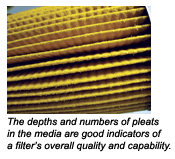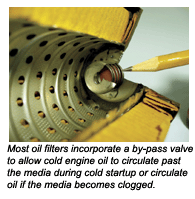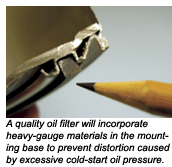Although oil filtration isn’t a new science, it’s important to remember that modern engine technology is placing new demands on oil filters. At the very least, modern engines require extremely clean oil for maximum reliability and longevity. But, more important, the use of synthetic lubricants and on-board monitored oil change intervals has allowed manufacturers to extend oil change intervals well beyond those of a few short years ago. Unfortunately, these extended oil change intervals make an oil filter work harder than ever to supply clean oil to vital engine parts.
Most veteran technicians remember when oil filters didn’t appear as standard equipment on many automobiles until mid-century. As time progressed, oil filtration became standard equipment because technical innovations such as hydraulic valve lifters or valve lash tensioners required clean, particle-free oil to ensure that check valves inside the lifter or tensioner would function perfectly during each valve-opening event. Disposable, full-flow “paper” oil filters became standard equipment during the 1960s for several reasons. First, their disposability greatly reduced the possibility of dirt contamination during storage or servicing. Second, the disposable filter could incorporate an anti-drain-back valve that prevented oil draining from the engine’s oil galleries into the oil sump. Third, the disposable filter could also incorporate an oil filter by-pass valve that would allow cold, highly viscous oil to flow past the filter media in order to provide full lubrication during cold startup. The by-pass valve would also allow oil to flow past a clogged oil filter media during normal engine operation. The fact that all of these features could be incorporated into a single, inexpensive, disposable component made the “throw-away” oil filter an attractive engineering option that has prevailed to the present day.
MODERN ENGINE TECHNOLOGY
Modern engines are more sophisticated, both in design and assembly, than engines of the past. Modern metallurgy has vastly improved engine life to the point that well-maintained engines are routinely reaching the 300,000-mile mark with only scheduled oil changes.
Oil technology has also made a dramatic leap forward with the introduction of synthetic and synthetic-blended oils. Modern engine oils, especially synthetics, are more resistant to oxidation, which is the basic tendency of any oil to combine with oxygen under high operating temperatures. Modern oils are also formulated to flow much better during cold startup and maintain viscosity at much higher operating temperatures. Last, advanced engine technology is requiring more application-specific oils that are designed to lubricate within the performance parameters of a particular engine design, which is a departure from the “generic” lubricating requirements of the past.
In addition, modern engines are often equipped with narrow, low-tension piston rings that are less tolerant of abrasive particles than the wider, higher-tension rings used in the past. Alloys used in modern hypereutectic pistons have enabled engineers to reduce piston-to-cylinder-wall clearances that, in turn, promotes better sealing for low-tension oil rings. Crankshaft bearing clearances have also been reduced to increase service life and to reduce the oil load on the piston rings. The net result of closer operating clearances is the reduction of oil consumption that, in turn, greatly extends oxygen sensor and catalytic converter life.
 MODERN OIL FILTERS
MODERN OIL FILTERS
Where does the modern oil filter fit into modern engine technology? Quite clearly, modern engines aren’t tolerant of abrasive particles suspended in the engine oil. Molybdenum-filled piston rings, for example, can produce a very long service life because the sponge-like molybdenum insert retains oil that lubricates the cylinder wall during cold starts and high-temperature operation. The soft molybdenum coating, however, is completely intolerant of abrasive particles suspended in the engine oil. Similarly, the precision piston and crankshaft bearing oil clearances, which are used to reduce oil spray onto the piston, can’t be maintained in the presence of abrasive particles.
 SLUDGING AND GELLING
SLUDGING AND GELLING
Although modern crankcase ventilation systems have practically eliminated water and other combustion by-products from accumulating in the crankcase, the problem of sludging and gelling is being aggravated by ever-longer recommended oil change intervals and skipped maintenance. Consequently, oil filtration has become more difficult because the service life of the lubricating oil is now being pushed at least to, or well past, its operational limits.
Although sludging and gelling are often considered to be one and the same, it’s important to consider the real-world differences. In general, sludging is usually caused by combustion by-products like water and carbon particles being suspended in the engine oil. Going back to basics, engines are designed to operate just under the boiling point of water (212° F) to evaporate condensed moisture from the engine oil into the crankcase ventilation system. During normal low-speed driving, engine oil temperatures hover near the coolant temperature. If the engine is driven on short trips, the oil temperature will run well below coolant temperature and cause the engine oil to accumulate excessive water, which then combines with carbon to form sludge.
 Oil sludging has a catastrophic effect on oil filter life because, during high-speed driving or after a fresh oil change, the sludge detaches from internal engine parts and clogs the oil filter media. Although quality oil filters are designed with sufficient media surface to trap normal accumulations of sludge, any oil filter can be quickly overwhelmed by excessive sludge. If the filter clogs, the internal oil filter by-pass valve allows unfiltered oil to circulate freely throughout the engine, which again reduces the life of precision-machined engine parts.
Oil sludging has a catastrophic effect on oil filter life because, during high-speed driving or after a fresh oil change, the sludge detaches from internal engine parts and clogs the oil filter media. Although quality oil filters are designed with sufficient media surface to trap normal accumulations of sludge, any oil filter can be quickly overwhelmed by excessive sludge. If the filter clogs, the internal oil filter by-pass valve allows unfiltered oil to circulate freely throughout the engine, which again reduces the life of precision-machined engine parts.
In contrast, gelling generally occurs when oil temperatures exceed normal operating parameters and the oil subsequently combines with atmospheric oxygen to form a gelatinous film on the internal engine parts. During high-speed or high-load operating conditions, engine oil temperatures generally run about 250° F, which is approximately 50-60° F above normal coolant temperatures. If the engine is operated at continuously high bearing loads, oil temperatures may reach 300° F or more. Since the flash or vaporization point of most engine oils begins in the 300-400° operating range, oxidation rates are rapidly increased. In extreme cases of high-temperature gelling, severely oxidized oil may congeal in the oil sump after the engine cools and may fail to circulate during the next cold startup.
It’s important to understand that gelling is very likely to occur when non-OE specification oil is used and/or when recommended oil change intervals are ignored. Worse still, gelling may cause a catastrophic lubrication failure by restricting the oil pump inlet screen. Like sludge, gelling may quickly accelerate engine wear by clogging the oil filter and allowing abrasive contaminants to circulate through the oil filter by-pass valve.
OIL FILTER INSTALLATION
After an oil filter is removed, always remember that the oil filter should be thoroughly drained by piercing the canister or by crushing and be disposed of in accordance with local environmental regulations. When installing a new filter, always wipe the filter base to remove dirt contamination and prevent the old filter gasket from sticking to the filter mount. The oil filter gasket should be lubricated with engine oil before installation to achieve correct installation torque and to expedite future removal. Because mounting torque and gasket sealing might be affected, grease should never be used to lubricate filter gaskets. Last, always hand-tighten the filter. If hand-tightening isn’t practical, use a filter cap wrench to duplicate hand-tightening torque.
OIL FILTER DESIGN
Unfortunately, one of the realities of our free-market system is that a routine service like an oil change is often sold to the motoring public as a highly commoditized, loss-leader service. The result is, of course, that many service outlets cut losses by installing oil filters that fail to protect an engine throughout a typically modern 7,500-mile oil change interval.
Cutting apart oil filters will reveal many design shortcuts, such as not including anti-drain back valves, reducing the surface area of filtering media, using non-OE specification filtering media, and using thinner filter canister and mounting base materials, to name a few. The lack of an anti-drain back valve, for example, might cause an engine to be noisy during initial startup. Installers might also forget that substandard filter media tends to disintegrate when subjected to moisture contamination from a failing cylinder head gasket. In short, always install a quality oil filter because any filter you install may remain on the engine until well after the modern, on-board oil condition monitoring system flashes the “oil change warning” light.

